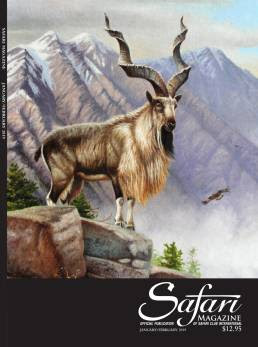The Safari Club International Convention kicked off today in Nashville, Tennessee. Along with the vendors, the auctions, and the entertainment, the convention features educational seminars on topics ranging from traveling with a firearm to how to write for hunters.
John Geiger, Managing Editor of Safari Magazine, and author Craig Boddington presented a “how-to” seminar on what you need to do to get published in SCI’s Safari Magazine. It is the editorial policy of Safari to publish stories from SCI members alongside those by professional outdoor writers. Indeed, they want these stories of members’ adventures whether it is hunting for Cape buffalo in Zimbabwe or waiting for a whitetail to appear below a tree stand in Alabama. They even pay a $25 honorarium to the author.

The editors are looking for complete stories which present adventure and emotion that are accompanied by great photos. They want to know about the challenges you faced, the exotic food you ate, and the differences you saw on the trip between home and this location. The story needs a beginning, a middle, and an end. The beginning might be the most exciting part of your adventure while while the end could be a reflection on this exciting part. The middle should provide the details of this trip or hunt. If you had a PH or outfitter, mention them. Just make sure to spell their name correctly.
As to the nuts and bolts, Geiger said it is important to use proper grammar and correct spelling. Along with a good dictionary, he said to use the AP Style Book as a reference. A SCI Publications Style Guide is available from him by sending a request for it by email to jgeiger@scifirstforhunters.org. A feature story might be as long as 2,000 words accompanied by 20-30 good photos. They prefer MS Word for the manuscript while the photos should be in high resolution (avg. size is 1.5 MB). JPGs are fine. If your camera allows you to take photos in RAW format, use it. You should send in the accompanying JPGs but keep the RAW file in case the photo editors needs to make any correction. Geiger emphasized that they do not want retouched photos.
Boddington took over the seminar from this point. He noted that writing might be a skill, a knack, or a talent but everyone does it differently. The point is to see what works for you. Being a reader helps as it exposes you to different writing styles. He said one of the most helpful books he found on writing was Stephen King’s On Writing (commission earned). King suggested that after you’ve written that first draft, go back and cut it by 10%.
Here are some of the suggestions for how to write and photograph the story from Boddington.
- Include the “hero shot”, i.e., you with the trophy animal.
- Include the rifle in the photo.
- Start with the high point.
- Alternatively, a diary format may sometimes work.
- Jack O’Connor’s books and stories included details on everything you needed to go on that hunt.
- Take notes!
- Have place names and spell them correctly.
- Get the names of all on the hunt including the trackers. Spell their names correctly and get the last names if possible.
- Focus story on the hunt for one animal and not the whole safari.
Boddington had some more suggestions regarding the photography that needs to illustrate the story.
- Include the skyline if possible in the trophy shot. “It makes antlers look good!”
- Change angles. Take a variety from straight on, from the side, and from a low angle.
- Take the trophy shot both with and without the firearm.
- Do a “walk-up” shot as if you are approaching the downed animal.
- Clean up your mess as much as possible. Clean blood off the animal.
- Keep the animals tongue out of the photo.
- Imagine how a non-hunter will view your photo.
- Pay attention to little stuff. For example, if your state requires blaze orange, be wearing it in the trophy shot.
- If you have lost the light of day, you may need to wait until the next day to take the photo. Not ideal but it may be your only choice.
- Scenery is good but add people to the photo. Instead of merely showing a canyon, have the hunter shown glassing the canyon.
- Remember the one-third rule of photography.
- Have action photos.
- Show people in camp.
- Do not retouch the photo. Let the photo editors do that.
- Caption your photos when submitting them – who, what, when, and why.
I found this seminar valuable as it illustrated what the editors want, how to do it most effectively, and ways to do it right.
This seminar will be repeated on Friday at 10am with author, TV host, and hunter Jim Shockey.

